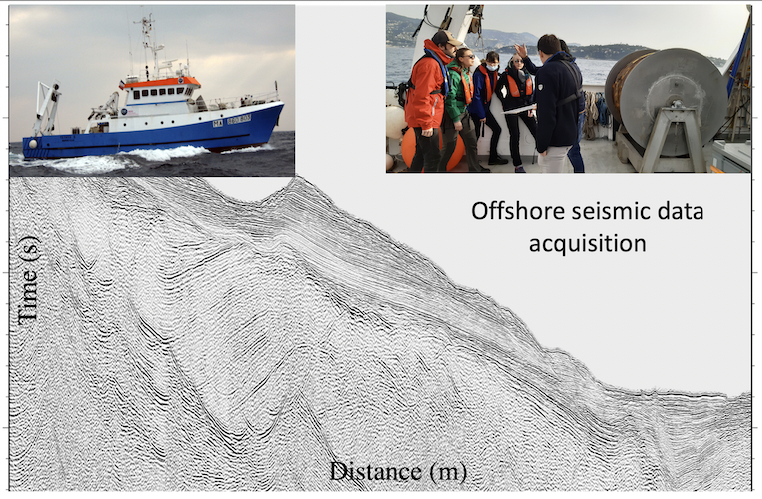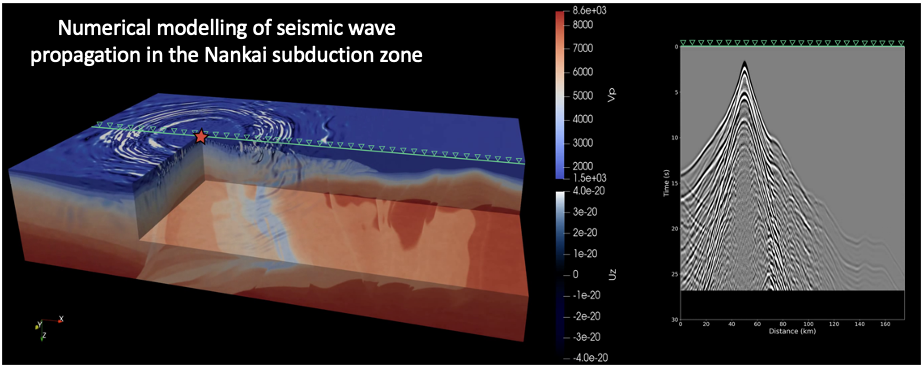Target level
Baccalaureate +5
ECTS
120 credits
Duration
2 years
Component
UFR PhITEM (physique, ingénierie, terre, environnement, mécanique)
Language(s) of instruction
English, French
Presentation
The "Geophysical Imaging of the Earth" program is for students interested in the understanding and evolution of the Earth's internal processes and structures, at different scales. It addresses several aspects of geophysics: environmental geophysics (changes in the cryosphere related to global warming, geothermal energy, hydrology, natural hazards...), fundamental geophysics (study of fault zones and earthquakes, volcano studies and monitoring, deep Earth dynamics...) and multi-scale and multi-physics imaging/monitoring.
These structures are mainly understood by their seismic, magnetic, electrical or gravimetric signatures, and their deformation movements. In the era of Big Data, the teaching is therefore resolutely oriented towards i) the acquisition of data during field and/or laboratory experiments, ii) the use of continuous observatory-type data, iii) their analysis via signal processing methods, as well as iv) their modelling and inversion by classical and advanced approaches (machine learning, use of numerical models...)
The students trained in the Geophysical Imaging of the Earth program will be able to demonstrate their skills as geophysical engineers and apply for jobs offered by design offices, public research institutes or large industrial groups concerned with the imaging, characterization and temporal monitoring of the physical properties of underground environments and their natural reservoirs in various environments. The main applications of this work are in the fields of seismology, civil engineering, natural hazard assessment, natural resource exploration and production including geothermal and hydrology, and the storage of fluids or solid wastes underground. There are many opportunities for internships in Earth science research laboratories (ISTerre in Grenoble), but also in operational research offices (BRGM) or in companies and design offices. The course also opens the way to a PhD.



International education
Internationally-oriented programmes
International dimension
Study abroad as an exchange student
As part of this track, you have the opportunity to study for a semester or a year at a UGA partner University abroad.
The International Relations Officers of your faculty will be able to provide you with more information.
More information on : https://international.univ-grenoble-alpes.fr/partir-a-l-international/partir-etudier-a-l-etranger-dans-le-cadre-d-un-programme-d-echanges/
Organisation
Program
Select a program
Master 1st year
UE Geophysical observation of the Earth
6 creditsUE Signal processing
6 creditsUE Programmation et environnements informatiques
3 creditsUE Waves Physics
3 creditsUE Physics and Chemistry of the Earth
6 creditsChoice: 3 among 3
UE Geomechanics
3 creditsUE Geophysical Prospecting
3 creditsUE Introductory Field Course - Professional project
3 credits
UE Deep Earth Geodynamics
6 creditsUE Exploration geophysics
6 creditsUE Data sciences & Inverse problems
3 creditsUE Volcanic dynamics and hazards
3 creditsUE Instrumentation for geophysics
3 creditsUE Introduction to Machine learning in Earth Sciences
3 creditsUE Scientific computing
3 creditsChoice: 4 to 6 among 2
UE Marine Geophysics
3 creditsUE Induced seismicity
3 credits
Master 2nd year
UE Frontiers in seismic imaging (Noise + FWI)
6 creditsUE Quantitative seismology
6 creditsUE Computing and data analysis Project
3 creditsUE Advanced signal Processing
3 creditsChoice: 2 to 3 among 5
UE Near surface geophysics
6 creditsUE Active Faults
6 creditsUE Doctoral School - InternalEarth@les Houches
6 creditsUE Advanced Machine Learning in Earth Sciences
3 creditsUE Numerical Modelling
3 credits
UE short Internship
6 creditsUE long Internship
24 credits
Admission
Access conditions
- The 1st year is open to students who have obtained a national diploma equivalent to a bachelor degree (licence) in a field compatible with that of the Master, or via a validation of their studies or experience
- Entry to the 2nd year may be selective. It is open to candidates who have completed the first year of a master in the field, subject to a review of their application
Public continuing education : You are in charge of continuing education :
- if you resume your studies after 2 years of interruption of studies
- or if you followed training under the continuous training regime one of the previous 2 years
- or if you are an employee, job seeker, self-employed
If you do not have the diploma required to integrate the training, you can undertake a validation of personal and professional achievements (VAPP)
Candidature / Application
Target
- Students in initial training who have obtained a bachelor degree (licence) in physics, mechanics or earth sciences
- Foreign students wishing to pursue their studies in the geophysics field in France
- Students in continuing education wishing to pursue advanced studies in the geophysics field
Fees
Tuition fees 2023-2024 : 243 € + 100€ CVEC
Prerequisites
The Geophysics program of the new master in EPES is intended for students with a background in Earth sciences and a strong preference for the physical sciences, numerical calculation and data processing, as well as students with a background in physics who are interested in the natural physics laboratory that is planet Earth. At the local level, the Physics, Earth and environmental sciences, Mechanics program of the bachelor degree (licence) in Earth sciences appears particularly suitable. Students from the bachelor in Mechanics and the bachelor in Physics may also apply.
And after
Further studies
Graduates of the EPES master Geophysics program can continue their studies with a doctoral thesis, or supplement their training with a specialisation in computer science or business management methods.
Reorientation
- A reorientation to the Georisks program is possible up to the end of the 1st year. Depending on the choice of UEs in semesters 7-8, reorientations to the Geodynamics or Georesources programs are also possible
- Lastly, there is a Geosciences gateway locally in the Physics master through two modules of this master, Imaging and waves in natural environments (3 ECTS) and Geophysical fluids and/or instabilities (3 ECTS), option Complex matter, living matter, allowing students who have followed these modules to join the Geophysics program in 2nd year


